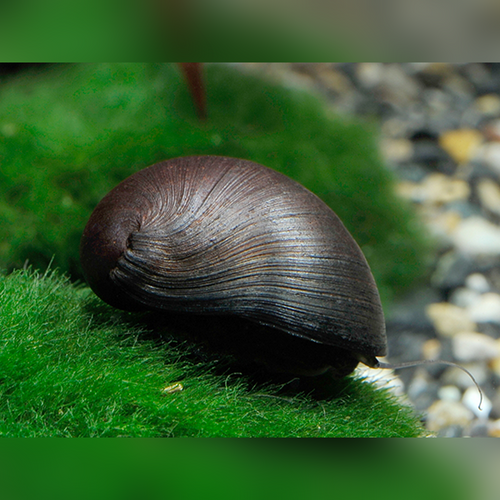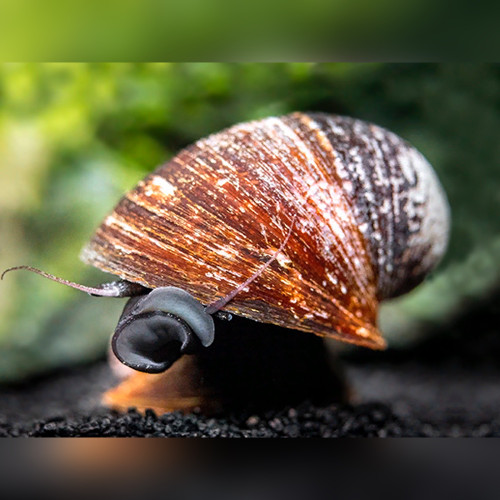Offering Black Military Helmet Nerite Snail (Neritina pulligera).
We offer “black” type of Neritina pulligera originally delivered from Thailand. Neritina pulligera «Black» is another great algae eating snail which is a great addition to planted tanks. Their shells are black. They have more a military helmet shape than tiger or zebra nerites.
The Military Helmet Snails are not fussy what they eat. Their primary diet is algae but will take anything your offer will be greatly received, algae wafers, blanched vegetables such as courgette and spinach, brussel sprouts, cucumber, fish flakes, shrimp pellets, red peppers and so on. These snails are harmless for healthy plants.
The good news is that Neritina pulligera «Black» care is pretty easy and straightforward. The snails are a hardy species and they are adaptable to a range of water conditions. They seem to like water temperature in the tropical community tank range of 22°C – 28°C. And some hobbyists suggest that Neritina pulligera can survive in a wider temperature range. Nerites also prefer water pH on the alkaline side around 7.5 and aquarium water on the hard side with a moderately moving current. As with other fish in a tank, Neritina pulligera care must also include checking for Ammonia spikes and high levels of Nitrate, as Nerites are susceptible. Care must also be taken to avoid any sort of exposure to copper and other medications because this can be fatal to snails. Finally, be mindful that the snails may need Calcium supplements to maintain a healthy shell.
Its also important to remember that Neritina pulligera care also includes how they are put into the tank. Avoid dropping them into the water and letting them float to the bottom to land in various random positions. Lucky Nerites will land upright and be able to quickly get acclimated to their new surroundings. The unlucky snails will land upside down. Nerite Snails have a very difficult time turning themselves over to the upright position. In most cases it’s almost impossible for them right themselves. Nerites left upside down can die that way. Make sure Nerites are placed in the tank in the upright position so they get off to a good start.
Neritina pulligera seem to enjoy being in an established planted aquarium. In an established planted tank, the water parameters have been given a chance to settle into a stable range and the tank has properly cycled. Also, the live aquarium plants continuously shed or discard plant matter into the water column, preventing the tank from ever being “too clean”. Nerites seem to be happy and content in tanks that are never “too clean”. Be sure not to cause an overstocking problem by adding snails. Just because Nerites are small they will increase the bio-load and they will tax the aquatic environment like other inhabitants in the tank.
The Black Military Helmet Snail lifespan is about one year, give or take. Sometimes Nerites die a week or so after being added to a tank, with others from the same batch living around 2 years or more. If a Nerite dies soon after being added to a tank it can be due to the stress of being transported, a significant shift in water parameters, or unhealthy water in the tank. Before adding snails to the tank, it may be a good idea to test both the tank water as well as a sample of the water that the snail is being transported in for pH, Ammonia, Nitrates and Hardness. It’s better to know in advance whether there is a significant variance in parameters.
If a Nerite Snail dies, be sure to remove it from the tank right away because a decomposing snail can cause an Ammonia spike in the aquarium water. A dead snail will not be affixed to the glass or any hard surface. Instead, a dead snail will usually be lying on the bottom of the tank, sometimes upside down and motionless. Upon removal from the tank, a dead snail may have a strong smell of rotting and decomposing flesh.
The Black Military Helmet Snails are very busy and active eaters. They affix themselves to hard surfaces such as glass, decorations, filter intakes and hard plant leaves. Nerites move easily across these surfaces…eating as they move. Nerite Snails are one of the best algae eating snails around, and their “from-tank” diet can include: soft film algae, soft green algae, soft brown algae, and brown diatoms. They dig down about an inch or so and eat off the glass for hours. Its a misconception to think that Nerite Snails will “eat away” algae problems in an aquarium. Algae problems are related to lighting issues and water conditions. If a tank has algae problems, adding some Nerites is not the best solution. Instead, determining the root cause of the algae problem is necessary. Once identified, properly addressing the issues is the best way to control algae.
Neritina pulligera do not seem to be interested in eating live plants. They feed either clustered in groups or on their own. And they seem to find food no matter where it may be. The snails can find food on glass, sponge filters and in power filters themselves. Because Nerites can get up into power filter boxes they can find themselves in pretty dangerous predicaments, so its best to keep the tank well covered to prevent them from escaping and getting hurt or killed. An interesting thing about Nerite Snails is that when they are in feeding mode, they are constantly on the go, moving steadily and tirelessly throughout the tank. Then, for no apparent reason, they become idle and still for long periods of time. When this happens, they may be out in the open on a hard leaf, on the glass, or on a filter intake, for instance. Or they may find a dark, quiet corner of the tank near the surface and stay there motionless for days.
It’s often noted that Nerite Snails will not reproduce in fresh water. Because Nerites need brackish water to reproduce successfully, they will not take over a fresh water tank like many other snails do. This is one of the primary benefits of this snail. That said, Nerite Snail eggs will begin to appear on many hard surfaces of the tank. Nerite Snail eggs look like little white dots and are most noticeable on dark surfaces like HOB filter intakes and dark aquarium heaters, on the glass, or on decorations and ornaments. Nerite Snail eggs are hard and will need to be scraped off to be taken out of the tank. Even though Nerite Snail eggs can be somewhat annoying, the advantages of these types of algae eating snails outweigh other types of snails that do reproduce in fresh water. This makes Nerite Snails a smart choice if you want to add a snail population to your tank.
Black Military Helmet Snails tank mates can include most invertebrates and fish appropriate for a freshwater community tank. Neritina pulligera tank mates should not include any aggressive invertebrates or fish because the snails may get eaten. So avoid loaches, aquarium crayfish, Goldfish and cichlids.
The image used above is for illustration purposes only. Please click here to see the snail’s profile explaining the keeping and breeding conditions for this species. We offer free shipping. Please carefully check our Delivery Conditions before you place an order.










